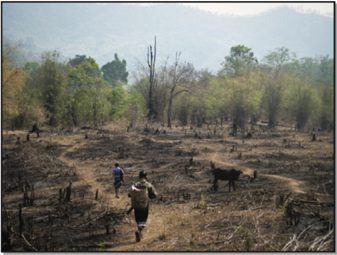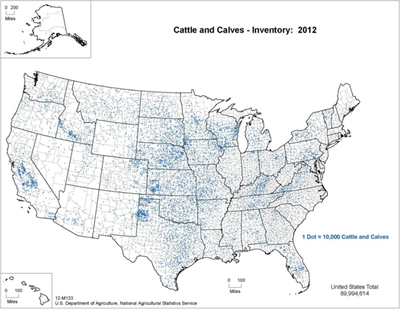
Unless you’ve lived a life in the fields, it is very difficult to understand the depth of the subject of agriculture. That said, taking an active effort to familiarize yourself with this industry can help you as a consumer and the environment as a whole. After all, there are so many agricultural practices, and this industry is crucial for the survival and growth of each living organism and the working of the ecosystem.
There is not one single or one right method per se, and each way has a different significance when we look at it from different parts of the world. Every region has access to different types of technology and follows distinct cultures. Let’s look at two popular practices followed in India and the United States and how they both impact their surrounding environment.
Shifting Cultivation in India

India has 8 major types of agricultural practices and nearly 1.73 million hectares under shifting cultivation. Shifting cultivation, which is also commonly referred to as Jhum, is an agricultural device where farmers shift between plots of land based on their fertility. They will cultivate one area of land until it becomes arid and then move onto another area while allowing the initial area to naturally revitalize itself.
Shifting cultivation has been popular for centuries among indigenous communities and since they typically reside in remote regions, with little access to alternatives, this practice continues to have a major presence in agriculture.
While this practice used to be sustainable in its early days, today it presents many challenges to the soil and the surrounding climate. For instance, due to economic pressures, the time spent cultivating the land is usually shorter than the time it’s given to regenerate, which leads to damaging effects in the long run.
This is particularly an issue because cultivating new plots of land requires farmers to cut down trees and burn the stumps, a process known as slash and burn, which results in mass deforestation and erosion. This system worked well when populations were small and there was a lot of available land since cultivated land was given ample time to regenerate naturally.
But since the global population is now rapidly growing and land is limited, these farmers are being forced to return to land that hasn’t fully recovered. And when a plot is repeatedly cultivated, the topsoil becomes vulnerable to water and wind erosion, which can render the land permanently unusable.
Another problem with slash and burn agriculture is that the excessive burning of trees and plants results in increased CO2 emissions and air pollution. And as many of us know, this contributes to global climate change, leading to erratic wildfires and creating a destructive feedback loop.
Luckily, the government and scientific authorities are aware of these challenges, which is the first step towards implementing effective changes. One solution that’s proven to have high success is SALT (Sloping Agriculture Land Technology) – a sustainable method of growing crops on sloped land.
In this method, thick rows of nitrogen-fixing plants are planted on the hills (hedgerows) and the crops are then seeded alongside these plants. The nitrogen-fixing plants help increase the nitrogen content in the soil which allows it to retain its fertility.
The SALT method has worked well for these low-income regions in South and Southeast Asia since it requires minimal land space and resources. However, in order for this to become ubiquitous, these farmers need access to proper training and public support.
Livestock Farming in the United States

Livestock farming is one of the fastest-growing agricultural practices in the world. In 2017, there were about 2.7 million livestock farms in the United States. Livestock farming is essential for the production of meat and dairy products. And with animal products in high demand and generous subsidies minimizing costs, livestock farming has become very popular. The US has approximately 94.4 million cattle and calves (beef and dairy) dispersed widely across the country.
However, similar to shifting cultivation, livestock farming is a leading cause of mass deforestation and environmental damage. In order to accommodate more livestock and create ranches, farmers need to cut down forests. This disrupts ecosystems since many animals and plant species are forced to lose their habitat.
In addition to this, the grazing of animals has a devastating impact on soil health. The friction from cattle hooves loosens up the soil and exposes it to erosion. And soil erosion introduces a variety of long-lasting problems such as lost soil biodiversity and an inability to store carbon.
Aside from the environmental consequences, livestock farming is also extremely resource-intensive. According to a report by the FAO, grazing occupies 26% of Earth’s land space while feed crop requires nearly a third of all arable land. All this resource could be used to support our growing human population but instead, we are exhausting it on livestock.
Unfortunately, unlike shifting cultivation, livestock farming faces two major challenges that prevent us from implementing effective changes. First, the demand for animal products has been on a consistent upward trend, making it difficult to minimize its production. Second, powerful corporations and governments have a lot of stake in this industry, which disincentivizes them to find solutions.
Despite this, some farmers and organizations are experimenting with solutions on a small scale. For example, Allan Savory, an ecologist and farmer from Zimbabwe, co-founded the Savory Institute which evaluates livestock farming methods on their environmental impact and recommends improvements. He also developed Holistic Management, a program that advises farmers on ways they can care for soil health and grazing land.
Meaningful solutions like these originate from public discourse and consumer pressure. It’s crucial to understand these farming processes and their adverse consequences, so we can fund farmer training programs and other resources, support organizations, and encourage governments to pass impactful policies.
Agriculture is a complex industry with a multitude of different methods that differ across countries and climates. But the common denominator is that we all rely on it for our diet and thus, need it to be a sustainable practice for centuries to come.
Below there are some other articles that you might be interested in:
- Why do we need chloride-free agriculture?
- Soil: Vital but Fragile
- Soil Biodiversity Might Just Be the Answer to Our Climate Prayers
This articles was saw first on the Chloride Free Foundation's website. If you want to know more about this non-profit organization, please make sure to click on this link.























